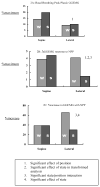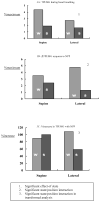Postural effects on pharyngeal protective reflex mechanisms
- PMID: 15532204
- PMCID: PMC3504469
- DOI: 10.1093/sleep/27.6.1105
Postural effects on pharyngeal protective reflex mechanisms
Abstract
Study objectives: Pharyngeal muscle dilators are important in obstructive sleep apnea pathogenesis because the failure of protective reflexes involving these muscles yields pharyngeal collapse. Conflicting results exist in the literature regarding the responsiveness of these muscles during stable non-rapid eye movement sleep. However, variations in posture in previous studies may have influenced these findings. We hypothesized that tongue protruder muscles are maximally responsive to negative pressure pulses during supine sleep, when posterior tongue displacement yields pharyngeal occlusion.
Design: We studied all subjects in the supine and lateral postures during wakefulness and stable non-rapid eye movement sleep by measuring genioglossus and tensor palatini electromyograms during basal breathing and following negative pressure pulses.
Setting: Upper-airway physiology laboratory of Sleep Medicine Division, Brigham and Women's Hospital.
Subjects/participants: 17 normal subjects.
Measurements and results: We observed an increase in genioglossal responsiveness to negative pressure pulses in sleep as compared to wakefulness in supine subjects (3.9 percentage of maximum [%max] +/- 1.1 vs 4.4 %max +/- 1.0) but a decrease in the lateral decubitus position (4.1 %max +/- 1.0 vs 1.5 %max +/- 0.4), the interaction effect being significant. Despite this augmented reflex, collapsibility, as measured during negative pressure pulses, increased more while subjects were in the supine position as compared with the lateral decubitus position. While the interaction between wake-sleep state and position was also significant for the tensor palatini, the effect was weaker than for genioglossus, although, for tensor palatini, baseline activity was markedly reduced during non-rapid eye movement sleep as compared with wakefulness.
Conclusion: We conclude that body posture does have an important impact on genioglossal responsiveness to negative pressure pulses during non-rapid eye movement sleep. We speculate that this mechanism works to prevent pharyngeal occlusion when the upper airway is most vulnerable to collapse eg, during supine sleep.
Conflict of interest statement
This is not an industry-sponsored study. Dr. Malhotra receives research support from Respironics. Dr. Fogel serves on the visiting speaker’s bureau for Wyeth Pharmaceuticals. Dr. White receives research support and consulting fees from Respironics, Itamar Medical, Aspire Medical, and the Alfred E. Mann Foundation. Drs. Trinder, Stanchina, Patel, Schory, and Kleverlaan have indicated no financial conflicts of interest.
Figures



References
-
- Malhotra A, White D. Seminar: Obstructive sleep apnoea. Lancet. 2002;360:237–45. - PubMed
-
- Berry RB, McNellis MI, Kouchi K, Light RW. Upper airway anesthesia reduces phasic genioglossus activity during sleep apnea. Am J Respir Crit Care Med. 1997;156:127–32. - PubMed
-
- Badr MS. Pathogenesis of obstructive sleep apnea. Prog Cardiovasc Dis. 1999;41:323–30. - PubMed
-
- Peppard PE, Young T, Palta M, Skatrud J. Prospective study of the association between sleep-disordered breathing and hypertension. N Engl J Med. 2000;342:1378–84. - PubMed
Publication types
MeSH terms
Grants and funding
LinkOut - more resources
Full Text Sources
Other Literature Sources
Medical

